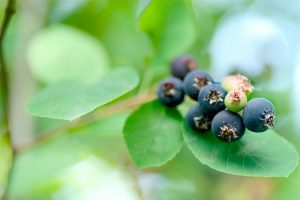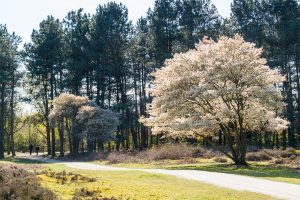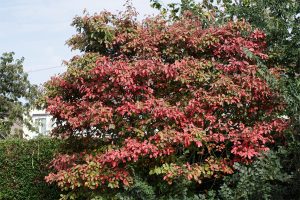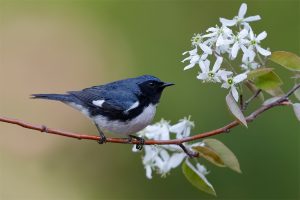This week we are shining the spotlight on Amelanchier grandiflora ‘Autumn Brilliance’. If you aren’t familiar with them yet, you ought to be. Known as Juneberry trees, or Apple serviceberrys, the Amelanchier grandiflora is a successful hybrid cross between two species of serviceberry trees, the Amelanchier arborea and Amelanchier laevis, Amelanchier x grandiflora. Hailing from the Rosaceae family, serviceberries get their name because their bloom coincides with the ground thawing, allowing churches to resume normal service routines, such as burials.
Serviceberry trees are native to the Chicago area, and this variety endures USDA plant hardiness zones 3-9. A showy specimen, Amelanchier grandiflora produces delicious berries about 3/8 of an inch in diameter, with a taste and appearance similar to blueberries. The berries emerge green, transition into red, and finally ripen as blue-black in June. In addition to the universal appeal of it’s fruit, the branches explode with grand clusters of highly fragrant white flowers.

Blooming early in the year, the flowers are abundant well before the leaves present themselves. As the seasons chug along, it’s 2 inch long oval-lanceolate leaves progress through an impressive spectrum of color. They emerge from the branches green with bronze tips in the spring, maturing into a dark olive green as spring progresses into summer, finally settling down into a bold brick red before they fall into winter dormancy.

This small, deciduous, multi-trunked tree grows to an equal height and spread of 15-25 feet, making it ideal for a small garden environment. With careful pruning in it’s youth though, it can be manipulated into a single trunk specimen. It’s veracity in expression of seasonal color makes it a stupendous choice when placed against a canvas of evergreens. Developing fissures as it ages, the smooth silvery grey bark is lovely to look at when exposed during the winter months.
A wide range of soils are tolerated, but moist, well-drained loamy soil is the Juneberry’s preference. Water requirements are moderate, and it has excellent resistance to diseases such as black walnut toxicity. Though resistant to many diseases, they are not entirely immune to problems. The Apple serviceberry trees can be prone to heat and drought stress, as well as developing rust and leaf spots.

Full or partial sun is sufficient, and the shallow roots will benefit from a healthy layer of mulch that will act as an insulator to provide soil temperature consistency, as well as conserving moisture.
The delectable berries of the Amelachier grandiflora tree are used in all sorts of jellies, pies and jams or can simply be eaten raw. It is a race against the avions to harvest the berries before the hungry birds snatch them all up. Deer seem to leave them alone, preferring other fruit. Serviceberries are also used to sweeten a traditional Native American dried meat pie known as Pemmican.

Taking into account their petite nature, ideal planting locations include residential sites and parks, city parkways, wide medians, or under utility lines. Shallow roots and their relatively small footprint also make them a great choice for patios and sidewalks, as well as border plants where space is limited.

